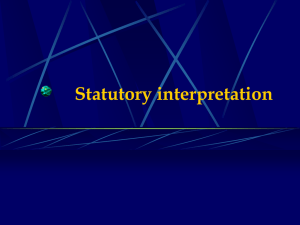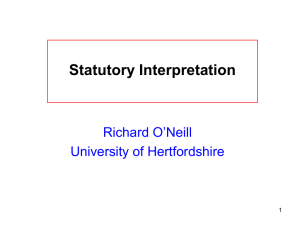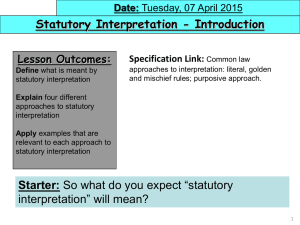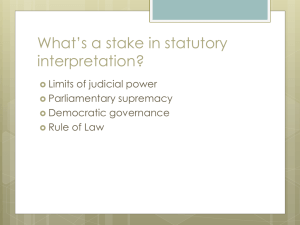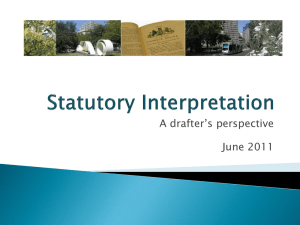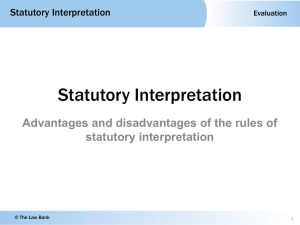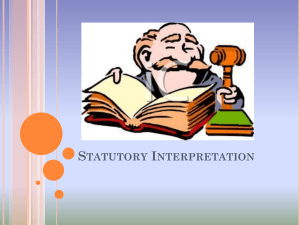1 Approaches to Statutory Interpretation
advertisement
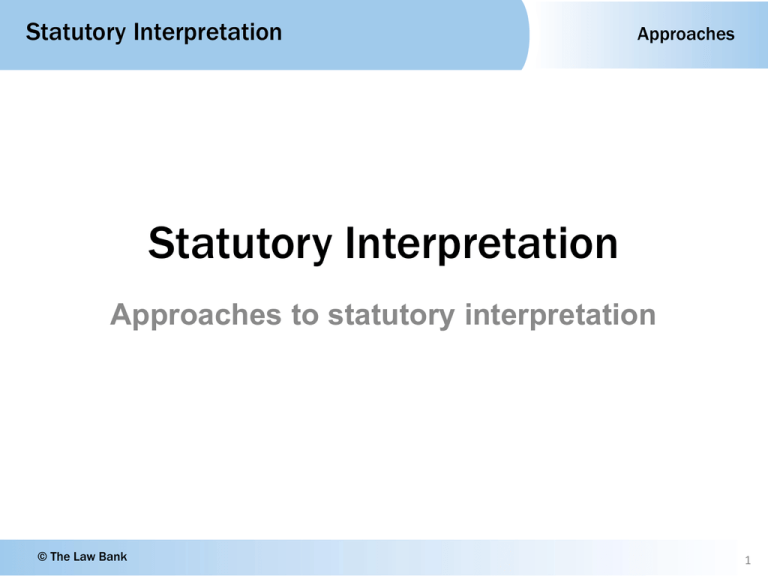
Statutory Interpretation Approaches Statutory Interpretation Approaches to statutory interpretation © The Law Bank 1 Statutory Interpretation Approaches Objectives • Define what is meant by statutory interpretation • Explain four different approaches to statutory interpretation • Apply examples that are relevant to each approach to statutory interpretation © The Law Bank 2 Statutory Interpretation Approaches Key Terms • Statutory interpretation • The literal rule • The golden rule • The mischief rule • The purposive approach © The Law Bank 3 Statutory Interpretation Approaches What is Statutory Interpretation? • • • • Legislation usually drafted by Parliamentary counsel Parliament’s role is to create legislation Judge’s role is to apply it No matter how hard Parliamentary counsel work to make clear always some issues with definition • Sometimes deliberately broad to allow flexibility • This often means that judges have to interpret the Acts • 75% of cases heard by Lords (now Supreme Court) are Statutory Interpretation © The Law Bank 4 Statutory Interpretation Approaches What is Statutory Interpretation? • • • • Judges are aided by materials inside and outside the Act Also by rules and presumptions These created by Judges themselves Not really rules only alternative ways a judge can interpret the Act • Judges make certain presumptions when interpreting an act – – – – Acts of Parliament are not retrospective The Crown is not bound There is no change in common law unless the Act specifically says so Mens Rea is required in all criminal cases © The Law Bank 5 Statutory Interpretation Approaches The Rules of Interpretation • Also known as the cannons of construction • Once Parliament has passed an Act, it then falls to the courts to apply the statute in a particular case. • This can lead to difficulties where: – facts of the case may not have been envisaged by Parliament – or where there exist drafting errors or ambiguity in the statute © The Law Bank 6 Statutory Interpretation Approaches The Rules of Interpretation • Referred to as 'rules' • Not strictly binding • Some commentators argue they are used to justify a decision rather than assisting the decision making process. – – – – Literal Rule Golden Rule Mischief Rule Purposive Approach © The Law Bank 7 Statutory Interpretation Approaches Literal Rule • The literal rule of statutory interpretation should be the first rule applied by judges. • Requires the judge to give the words of the statute their natural, ordinary or dictionary meaning • Should be applied without the judge seeking to put a gloss on the words or seek to make sense of the statute. • This is the case even if it appears to be contrary to rules of Parliament © The Law Bank 8 Statutory Interpretation Approaches Literal Rule • Lord Reid in Pinner v Everett [1969]: – ‘In determining the meaning of any words or phrase in a statute, the first question to ask is always what is the natural and ordinary meaning of that word or phrase in its context in the statute.’ • This may lead to unexpected results that were not the intention of Parliament. © The Law Bank 9 Statutory Interpretation Approaches R v Harris (1836) 7 C & P 446 The defendant bit off his victim's nose. Principle – The statute made it an offence 'to stab cut or wound' the court held that under the literal rule the act of biting did not come within the meaning of stab cut or wound as these words implied an instrument had to be used. Therefore the defendant's conviction was quashed. © The Law Bank 10 Statutory Interpretation Approaches Whitely v Chappel (1868) LR 4 QB 147 A statute made it an offence 'to impersonate any person entitled to vote.' The defendant used the vote of a dead man. The statute relating to voting rights required a person to be living in order to be entitled to vote. Principle – The literal rule was applied and the defendant was thus acquitted. © The Law Bank 11 Statutory Interpretation Approaches Fisher v Bell [1961] 1 QB 394 The defendant had a flick knife displayed in his shop window with a price tag on it. Statute (The Restriction of Offensive Weapons Act 1959) made it a criminal offence to ’sell or offer for sale' such flick knives. Principle – The court applied the literal rule of statutory interpretation. His conviction was quashed as in contract law, goods on display in shops are not 'offers' in the technical sense but an invitation to treat. The court found D not guilty even though it was obviously Parliament’s intention to stop the sale of these types of weapons. © The Law Bank 12 Statutory Interpretation Approaches Golden Rule • May be applied where an application of the literal rule would lead to an absurdity. • The courts may then apply a secondary meaning. (River Wear Commissioners v Adamson) (1876-77) L.R. 2 App Cas 743. • This will avoid an absurd result • Two approaches – Narrow approach – Broad approach © The Law Bank 13 Statutory Interpretation Approaches Golden Rule – Narrow Approach • Applied when the word or phrase is capable of more than one literal meaning. • This allows the judge to apply the meaning that avoids an absurdity. • R v Allen (1872) gives a perfect example. © The Law Bank 14 Statutory Interpretation Approaches R v Allen (1872) LR 1 CCR 367 The defendant was charged with the offence of bigamy under s.57 of the Offences Against the Person Act 1861. The statute states 'whosoever being married shall marry any other person during the lifetime of the former husband or wife is guilty of an offence'. Under a literal interpretation of this section the offence would be impossible to commit since civil law will not recognise a second, any attempt to marry in such circumstances would not be recognised as a valid marriage. Principle – The court applied the golden rule and held that the word 'marry' should be interpreted as 'to go through a marriage ceremony'. The defendant's conviction was upheld. © The Law Bank 15 Statutory Interpretation Approaches Golden Rule – Broad Approach • Applied when there is only one literal meaning but applying it would cause an absurdity • Under Broad approach court will modify the meaning to avoid absurdity. • Adler v George (1964) is the example here © The Law Bank 16 Statutory Interpretation Approaches Adler v George [1964] 2 QB 7 Under the Official Secrets Act 1920 it was an offence to obstruct a member of the armed forces 'in the vicinity' of a prohibited palace. The defendant was actually in the prohibited place, rather than 'in the vicinity' of it, at the time of obstruction. Principle – The court applied the golden rule. It would be absurd for a person to be liable if they were near to a prohibited place and not if they were actually in it. His conviction was therefore upheld. © The Law Bank 17 Statutory Interpretation Approaches Re Sigsworth [1935] 1 Ch 98 A son murdered his mother. She had not made a will. Under the statute setting the law on intestacy he was her sole issue and stood to inherit her entire estate. Principle – The court applied the Golden rule holding that an application of the literal rule would lead to a repugnant result. He was thus entitled to nothing. © The Law Bank 18 Statutory Interpretation Approaches Golden Rule • Provides an opportunity for judicial law making • Narrow approach allows them to choose between several meanings • Broad approach allows modification of the meaning of the words used by Parliament. © The Law Bank 19 Statutory Interpretation Approaches Mischief Rule • Oldest of the rules. • Established in Heydon’s Case[1584] • In Re Sussex Peerage, it was held that the mischief rule should only be applied where there is ambiguity in the statute. • Under the mischief rule the court's role is to suppress the mischief the Act is aimed at and advance the remedy. © The Law Bank 20 Statutory Interpretation Approaches Mischief Rule • Court looks at gap in law that Parliament felt necessary to close. • Then interprets the Act to fill that gap and remedy the ‘mischief’ Parliament had been aiming to remedy. © The Law Bank 21 Statutory Interpretation Approaches Heydon's Case [1584] EWHC Exch J36 In an action determining the validity of a lease the court formulated the mischief rule. Principle – 1. What was the common law before making the Act? 2. What was the mischief and defect for which the common law did not provide? 3. What was the remedy Parliament passed to cure the mischief? 4. What was the true reason for the remedy? The role of the judge is to suppress the mischief and advance the remedy. © The Law Bank 22 Statutory Interpretation Approaches Mischief Rule • Where an Act has been passed to remedy a weakness or defect in the law, the interpretation that will correct the weakness or defect is the one that should be taken. © The Law Bank 23 Statutory Interpretation Approaches Smith v Hughes [1960] 1 WLR 830 The defendants were prostitutes who had been charged under the Street Offences Act 1959 which made it an offence to solicit in a public place. The prostitutes were soliciting from private premises in windows or on balconies so could be seen by the public. Principle – The court applied the mischief rule holding that the activities of the defendants were within the mischief the Act was aimed at even though under a literal interpretation they would be in a private place. © The Law Bank 24 Statutory Interpretation Approaches Mischief Rule • Where an Act has been passed to remedy a weakness or defect in the law, the interpretation that will correct the weakness or defect is the one that should be taken. • Provides scope for judicial law making as it allows judges to decide what they think Parliament intended to put right in the previous law. • The judges do not focus on the words as stated by Parliament. © The Law Bank 25 Statutory Interpretation Approaches Purposive Approach • Mischief Rule – looks back at common law before Act was passed to find gap in law that Parliament trying to fill • Purposive approach focuses on what Parliament intended. • Modern version of Mischief Rule • Distinction between the two a minor technicality • In Pepper (Inspector of Taxes) v Hart (1993) Lord Browne-Wilkinson: "the purposive approach to construction now adopted by the courts in order to give effect to the true intentions of the legislature". © The Law Bank 26 Statutory Interpretation Approaches Pepper (Inspector of Taxes) v Hart (1993) 1 All ER 42 This case concerned the tax liability of teachers at a public school where one of the perks of the job was that their sons could be educated at one fifth of the usual cost. This perk was a taxable benefit under s.61(1) of the Finance Act 1976 as it was a cash equivalent. The question for the House of Lords was how much tax should be levied. Principle – Responses made by the Financial Secretary to the Treasury during the Committee stage of the bill to queries regarding concessions enjoyed by railway men made it clear that tax should be levied at the marginal cost incurred by the employer. Adopting this interpretation, tax should be assessed on the basis of the marginal cost to the employer, not on the average cost of providing education for the employees' sons and the public. © The Law Bank 27 Statutory Interpretation Approaches Purposive Approach • Increasingly used by UK Courts since UK joined European Union • EU law drafted in broad terms • Lord Denning commenting on EU law in Bulmer Ltd v J Bollinger SA (1974): “All the way through the Treaty there are gaps and lacunae. These have to be filled in by the judges, or by regulations or directives. It is the European way.” © The Law Bank 28 Statutory Interpretation Approaches Purposive Approach • Judges in UK employ the Purposive Approach when dealing with European Law • Human Rights Act 1998 is another influence acting on Judges – Legislation must conform to HRA • Considerable shift to Purposive Approach • In line with Law Commission Report on Interpretation of Statutes 1969 © The Law Bank 29 Statutory Interpretation Approaches Pepper (Inspector of Taxes) v Hart (1993) 1 All ER 42 The Court of Appeal had to decide whether the physical and verbal abuse of a young black worker by his workmates fell within ‘the course of employment’ under s32 of the Race Relations Act 1976. The employer had argued that these actions fell outside the course of the workmate’s employment, because such behavior was not part of their job. The Employment Appeal Tribunal could not therefore be held responsible to the young black worker for his workmate’s behaviour. Principle – This decision was reversed by the Court of Appeal using the purposive approach to interpret s32. Parliament’s intention when enacting the Race Relations Act was to eliminate discrimination in the workplace and this would not be achieved by applying a narrow construction to the wording. © The Law Bank 30 Statutory Interpretation Approaches Purposive Approach • Provides scope for judicial law making • Judge is allowed to decide what he/she thinks Parliament intended the At to say not what the Act actually says © The Law Bank 31 Statutory Interpretation Approaches Objectives • Define what is meant by statutory interpretation • Explain four different approaches to statutory interpretation • Apply examples that are relevant to each approach to statutory interpretation © The Law Bank 32
